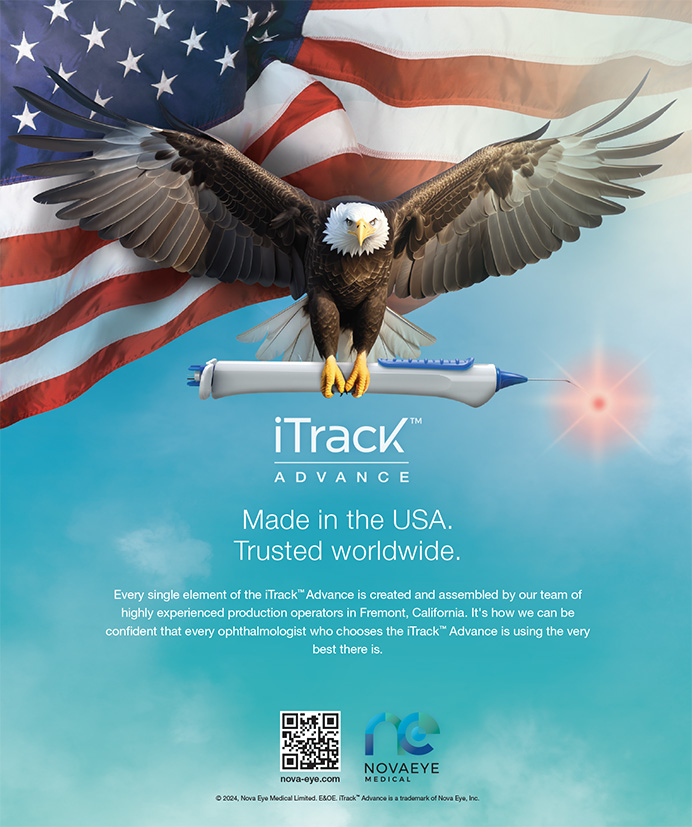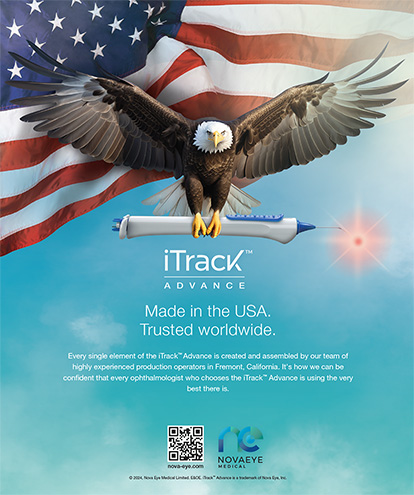CASE PRESENTATION
A 39-year-old white female initially presented for refractive consultation in February 2002. Her manifest refractive error was -7.00 +0.5 X 45 OD, yielding 20/20 BCVA, and -7.00 + 0.25 X 80 OS, yielding 20/20 BCVA. Her pupils were 6.0 mm in photopic conditions and 8.0 mm in scotopic conditions. Central keratometry was 45.12 @72/44.12 @162 OD and 45.25 @78/44.5 @168 OS. The patient's preoperative topography is shown in Figure 1. Her IOPs were 20 mm Hg OU and the central pachymetry was 590 µm OU. The anterior segment exam was normal except for mild blepharitis, which was pretreated 1 week prior to surgery with Tobradex eye drops (tobramycin and dexamethasone ophthalmic suspension; Alcon Laboratories, Fort Worth, TX) and doxycycline 100 mg both b.i.d. The posterior exam showed a cup-to-disc ratio of 0.1 and was otherwise normal. The patient and I discussed her refractive surgery options, especially her large scotopic pupils and the potential for glare and halos. After informed consent, she elected to undergo bilateral LASIK in March 2002.
I performed myopic LASIK using a Hansatome Microkeratome (Bausch & Lomb, San Dimas, CA; 8.5-mm ring and 180-µm head) in conjunction with an S3 laser (VISX, Santa Clara, CA; 6.5-mm optical zone with a blend zone). The target refraction was plano.
On the first postoperative day, the patient's UCVA was 20/40 OD and 20/30 OS. Despite mild flap edema, her postoperative exam was otherwise normal. At the patient's 2-week postoperative visit with her referring physician, she showed a slight interface haze diagnosed as mild DLK. She continued her topical Pred Forte 1% (prednisolone acetate 1%; Allergan, Inc., Irvine, CA) as instructed, and, in fact, increased the dosage from four to six times per day per her physician. I examined the patient on the following day.
HOW WOULD YOU PROCEED?1. What tests should you perform?
2. What is the significance of the patient's flap edema on postoperative day 1, and the lack of interface inflammation at that point?
3. Could anything have been done preoperatively to avoid the present situation?
SURGICAL COURSE
I examined the patient 15 days after her original surgery. Her UCVA was 20/40+1 OD and 20/40 +2 OS. At this visit, her manifest refractive error was -1.25 +0.5 X 10, yielding 20/30 BCVA and -1.25 +0.75 X 75, yielding 20/25 BCVA. Her slit lamp exam showed +1 -2 haze with diffuse interface fluid and a ground glass appearance in both eyes. Her central IOP measured at 14 mm Hg OU with a Tonopen (Mentor O & O, Norwell, MA); however, an IOP taken outside of the flap was 32 mm Hg OD and 36 mm Hg OS. The patient had no previous history of glaucoma, family history of glaucoma, or steroid responsiveness. I prescribed Timoptic (timolol maleate ophthalmic solution; Merck & Co., Inc., Whitehouse Station, NJ) 0.5% and Alphagan (brimonidine tartrate ophthalmic solution; Allergan Inc.) in both eyes b.i.d. Although the patient's IOP responded, she developed superficial punctate keratopathy related to the topical beta-blocker. I discontinued the beta-blocker and prescribed Xalatan 0.005% (latanoprost ophthalmic solution; Pharmacia Corporation, Peapack, NJ) at bedtime. Over the course of 2 months, the patient's interface fluid and haze slowly resolved. Five months after her surgery, the patient's UCVA is 20/30-2 OD and 20/25 OS. Her manifest refractive error is -1.00 +0.5 X 10, with 20/25+2 BCVA and -0.50, yielding 20/20 vision. The patient is presently considering an enhancement in the right eye.
OUTCOME
The LASIK Interface Fluid syndrome is an uncommon situation that occurs in my practice at a rate of 0.067%, or roughly 1/1,500 eyes. The first presentation of the syndrome that I saw was on March 12, 2000 at the American College of Eye Surgeons by Steve Turner, MD. Primarily, the presentation occurs within the first week to 1 month after surgery, and in many cases (such as this one) mimics a DLK syndrome. In fact, most surgeons initially increase postoperative corticosteroids when they should be discontinued for this reason.
In my experience, patients have usually had preoperative treatment of eyelid margin disease with an antibiotic-corticosteroid preparation. The overwhelming majority of my patients with the syndrome appear to respond to corticosteroids. The theory is that the increase in IOP drives fluid into the potential space created with the LASIK flap. The patient presents with a ground glass or haziness to the cornea with or without fluid cysts in the interface. When the surgeon uses Goldmann applanation tonometry (Haag- Streit, Bern, Switzerland) or Tonopen tonometry over the center of the flap, many cases will falsely show a low IOP because the fluid-filled interface creates an erroneously low reading.
Taking the IOP with Tonopen tonometry outside the edge of the LASIK flap will provide a true measurement. I prefer to cease using topical corticosteroids and to initiate pressure-lowering medications. Although I have not found hypertonics to be beneficial in most patients, it does work for a few. Initially, I used beta-blockers as an option, but because of the dry eye syndrome produced by the creation of the LASIK flap in many individuals, other glaucomatous regimens should be entertained. Most of these patients are corticosteroid responders, and if they undergo an enhancement after the original procedure, the surgeon should keep this in mind.
Karl G. Stonecipher, MD, is Director of Refractive Surgery at Southeast Eye Center in Greensboro, North Carolina. He does not hold a financial interest in any of the materials presented herein. Dr. Stonecipher may be reached at (800) 632-0428; stonenc@aol.com.

